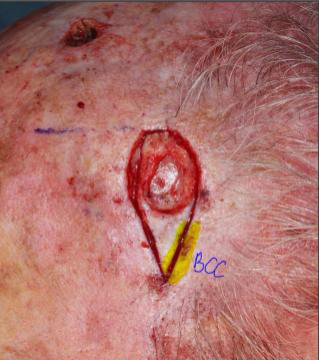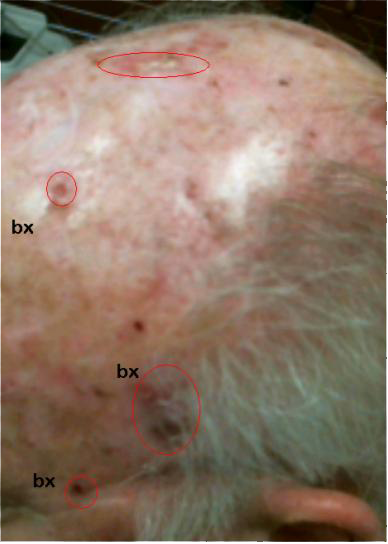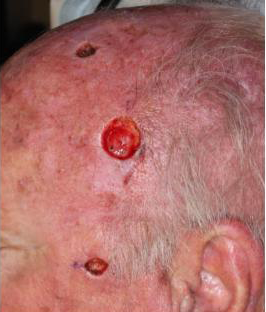Multiple Skin Cancers in an Organ Transplant Recipient
HISTORY
71-year-old organ transplant recipient presents with several SCC’s of scalp and face. Mohs excisions and closures were performed. Tissue of the left temple incidental to reconstruction was submitted for histologic analysis. Incidental BCC was found in the specimen requiring additional treatment. 4 to 6 o’clock margin was involved.
The patient with bilateral kidney transplants and is currently on Sirolimus (Rapamune) and Tacrolimus (Prograf).

Excision of Burrow’s triangle and surrounding tissue in preparation for a rotation flap closure of the left temple defect. The area with incidentally discovered BCC is marked in yellow.
DISCUSSION
The risk of skin cancers in organ transplant recipients (OTR) is substantially higher than normal population. SCC is the most common skin cancer in OTR, but melanoma, Kaposi’s sarcoma, and Merkel cell carcinoma are also increased in frequency. Immunosuppression is the immediate cause, with viral triggering of cancer growth considered a contributing factor. HPV is implicated in squamous cell carcinoma, polyomavirus in Merkel Cell carcinoma, and herpes virus in Kaposi’s sarcoma.
Immunosuppressive drugs have variable carcinogenicity with newer drugs exhibiting lower rates of skin cancer induction and some even inhibiting skin cancer formation. Two of the drugs demonstrated an elevated skin cancer rate: Azathioprine and cyclosporine. Mycophenolate has shown a lower rate of skin cancer induction. But mTor inhibitors such as sirolimus (Rapamune) are showing an inhibitory effect for skin cancer formation.
Here is a list from the most to the least skin cancer contributors.
Azathioprine, an antiproliferative drugs that inhibits inosine monophosphate dehydrogenase (IMDH), is an older drug associated with elevated skin cancer rates in OTR.
Cyclosporine, a calcineurin inhibitor, has been called a skin cancer “fertilizer”.
Tacrolimus (Prograf) is a newer calcineurin inhibitor that has lower risk of skin cancer induction than its older cousin cyclosporine.
Mycophenolate mofetil (Cellcept), a prodrug of mycophenolic acid, is also an IMDH inhibitor, but has much lower rate of skin cancer induction.
Sirolimus (Rapamune) is an mTor inhibitor (mammalian target of rapamycin inhibitor) that is considered a “game changer” for minimizing skin cancers in OTR patients. It has an anti-tumoral effect in organ transplant recipients with squamous cell carcinoma.
Transplant teams control the selection of immunosuppressive drugs. However, skin cancer treatment team should be aware of skin cancer development in patients under their care.
Reference
Geissler, E. K. (2015). Skin cancer in solid organ transplant recipients: are mTOR inhibitors a game changer? Transplantation Research, 4, 1. http://doi.org/10.1186/s13737-014-0022-4


